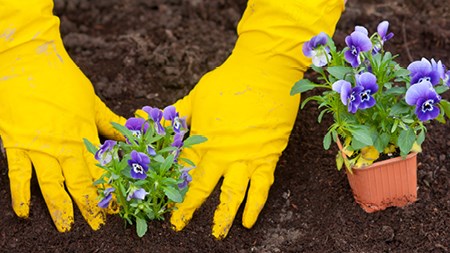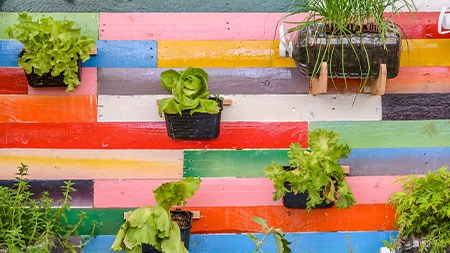Oh dear. The trees are beginning to look decidedly autumnal: winter’s pretty much here. Time to start unpackin’ the heaters and mulling the glühwein? Almost. But more importantly, it’s time to prepare your garden for the harshest months of the year.
VEGETABLES
It helps to have a bit of a siege mentality if you want your veggie garden to survive and thrive in the dry, cold winters in places like Gauteng, the Free State, and the Karoo.
Anyone who lives in any of these areas will tell you: the idea of a frost-resistant seedling? It’s a myth. Most small plants will succumb to the icy, sub-zero temperatures that like to assault us in winter here in Sunny South Africa - which is why now’s a good time to start investing in cloches and even, perhaps, a simple, plastic-covered growing tunnel for your vegetable garden.
Cloches are small, individual protectors used to cover young plants in their growing beds - so, for example, you could cut the bottom off a 2-litre plastic cool-drink bottle, remove the label and the cap, and place your new cloche over one of your seedlings. Some people remove their cloches during the day - which is probably a good idea in South Africa, because it allows the plants to absorb the sunlight they need, and prevents the formation of fungi.
What to plant this month? Broad beans, garlic, and dwarf spinach in most parts of the country; leeks, lettuce, parsnips, radishes, and Swiss chard in the Gauteng and Free State Highveld. In the Lowveld and similar warm, frost-free areas, you’re spoiled for choice: beetroot, Brussels sprouts, cabbages, capsicum, carrots, celery, cucumber, dwarf beans, eggplants, endives, horseradish, leeks, lettuce, parsley, peas, pumpkins, radishes, runner beans, Swiss chard, tomatoes, and turnips (amongst others). And in the winter rainfall areas of the Cape, you can choose from beetroot, cabbages, carrots, celery, endives, kohlrabi, leeks, lettuce, onions, parsley, parsnips, peas, radishes, Swiss chard, and turnips.
And remember: mulch, mulch and mulch again.
Mulch is any material that’s spread over the soil to help it retain its warmth and moisture. It can be made of any loose organic stuff - straw, leaf litter - or even of things like old carpet or plastic sheeting (you’ll have to cut slits for the plants to grow through, of course...). But beware of bark chips, even though many people do punt them heavily: they often deplete the soil of its nutrients during decomposition.
FLOWERING THINGS
April’s a good time to lift and divide over-crowded clumps of plants like agapanthus, day lilies, Dietes, red-hot pokers, and Watsonias (they’ll thank you in summer), and to plant freesias, hyacinths, snowdrops (Leucojum), Narcissus, chincherinchees (Ornithogalum thyrsoides, ranunculus, Sparaxis (harlequin flower), Tritonias and ‘treated’ tulips (temperature-treated to ensure that they’ll flower in August in the Southern Hemisphere - when our conditions look similar to those of the Dutch springtime).
April’s also a good time for propagating hardwood cuttings from your favourite shrubs.
Make your cuttings from well-matured wood off branches that emerged in the spring. As a general rule, cuttings should be about 20 to 25 cm in length - after you’ve removed the softest growth at the apex (you should also remove the leaves from the lower two-thirds of the stem). Use clean, sharp secateurs to cut the base just below a node or leaf-point, and dip the base in a hardwood rooting hormone like Dynaroot 3 - which comes in powder form - or a liquid like Dip & Root (for an overview of rooting hormones available on the South African market, see Farmer’s Weekly: ‘Increasing root growth’).
Prepare a shallow, v-shaped trench in a protected part of the garden. Pack the lower third with coarse river sand, and plant your cuttings directly into it, filling the trench with regular soil, and firming the soil around each cutting as you go. Watering is crucial, particularly in the summer rainfall areas, where you must take care to keep the soil moist (but not saturated) during the dry months of the winter.
Your cuttings should root - and be ready to plant into bags our out into the garden itself - by late winter or early spring.
BUY YERSELF A PRESENT! (AND ONE FOR THE PLANET, TOO).
We all need a good perk-me-up when the days start getting shorter, and the nights start feeling cooler - and the best perk-me-ups are those that perk others up, too.
So why not perk the entire planet?
South Africa is blessed with the widest variety of flowering shrubs and bulbs (thank you the fynbos of the Cape!), and a brilliant selection of indigenous trees (from the quick-growing fever tree - Acacia xanthophloea - to the slow and stately yellowwoods - Podocarpus falcatus or Podocarpus latifolius - and it boasts some of the finest garden centres, too (see this list from the South African Nursery Association).
So here’s your plan for perking the planet (and why it’ll benefit you in the medium term): visit your local garden centre now, and invest in the shrubs and trees you’ve been wanting to buy all along. And ignore those old-wives tales about spring being the best time for planting.
Because if you plant them now, your shrubs and trees will harden off over the autumn and winter - which will give them a head start over anything you’ll plant in September or October.
And that’ll make your garden spectacular come summer.




